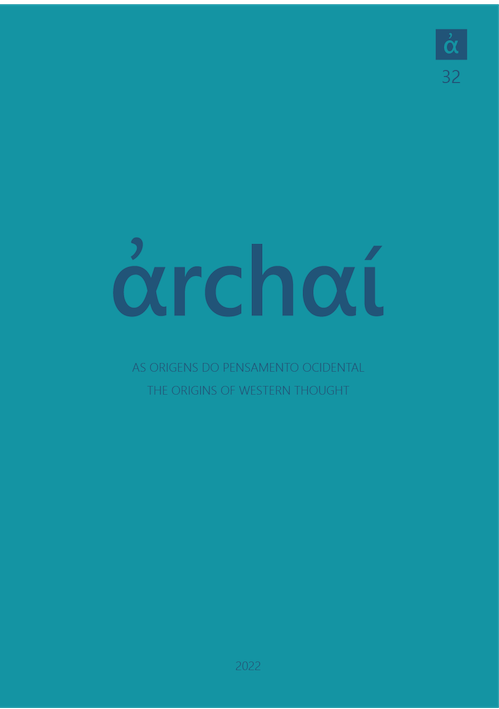Una elección imposible: conocer y no conocer en el Aviario (Teeteto196c7-d2)
DOI:
https://doi.org/10.14195/1984-249X_32_26Palavras-chave:
conocimiento, contradicción, error, falsedad, juicioResumo
En este trabajo examino la “elección imposible” que Sócrates le plantea a Teeteto: elegir entre aceptar (a) que el juicio falso es imposible, o (b) que es posible conocer y no conocer el mismo objeto (Teeteto196c7-d2). De acuerdo con la interpretación tradicional, Sócrates afirma que es necesario aceptar una de las dos opciones: (b). En consecuencia, Platóndesarrollaría el Aviario como un modelo de explicación del error en el que es posible conocer y no conocer lo mismo. Aquí argumento en contra de esta lectura. Sostengo que Sócratesafirmaque se deben rechazar las dos opciones(a) y (b), y, por ende, el Aviario presenta un modelo en dondeel juicio falso es posible sin aceptar que es posible conocer y no conocer lo mismo.
Referências
ACKRILL, J. (1966). Plato on False Belief: Theaetetus187-200. Monist50, n. 3, p. 383-402.AMBUEL, D. (2015). Turtles All the Way Down: On Plato’s Theaetetus, a Commentary and Translation. Sankt Augustin, Academia Verlag.
ARAÚJO, C. (2020). Disposition in the Aviary Model. En: BOSSI, B.; ROBINSON, T. M. (eds.). Plato’s Theaetetus Revisited. De Gruyter, Berlin/Boston, p. 159-72.
BARCELÓ ASPEITIA, A.y GONZÁLEZ-VARELA, E.(próxima aparición).Plato on False Judgement in the Theaetetus. Journal of the History of Philosophy.
BENSON, H. (1992). Why is There a Discussion of False Belief in the Theaetetus? Journal of the History of Philosophy30, n. 2, p. 171-99.BOERI, M. (2006). Platón. Teeteto(traducción, introducción y notas).Buenos Aires, Losada.
BOLOTIN, D. (1987). The Theaetetusand the Possibility of False Opinion. Interpretation15, n. 2-3, p. 179-193.
BOSTOCK, D. (1988). Plato’s Theaetetus. Oxford, Clarendon Press.BURNYEAT, M. (1990). The Theaetetus of Plato. Indianápolis: Hackett Publishing Co.
CHAPPELL, T. (2001). The Puzzle about the Puzzle of False Belief: Theaetetus188a–c. Bulletin of the Institute of Classical Studies45, p. 97-111.
COOPER, J. (1990). Plato’s Theaetetus. London and New York, Garland Publishing.
CORNFORD, F. M. (1935). Plato’s Theory of Knowledge: The Theaetetus and the Sophist(traducción, introducción y comentario). Nueva York, Harcourt, Brace and Company.CRIVELLI, P. (1996). The Argument from Knowing and Not Knowing in Plato’s Theaetetus(187e5-188c8). Proceedings of the Aristotelian Society96, n. 1, p. 177-96.
DUKE, E. A. et al. (ed.) (1995). Platonis Opera, t. I. Oxford, Clarendon Press.FERRARI, F. (2011). Platone. Teeteto(traducción, introducción y notas). Milán, Biblioteca Universale Rizzoli.FINE, G. (1979). False Belief in the Theaetetus. Phronesis24, n. 1, p. 70-80.
GONZALEZ, F. (2007). Wax Tablets, Aviaries, or Imaginary Pregnancies? On the Powers in Theaetetus’ Soul. Études platoniciennes4, p. 273-93.
LEVETT, M. (1997). Plato. Theaetetus(traducción, rev. M. Burnyeat). En: COOPER, J. (ed.). Plato. Complete Works. Indianápolis, Hackett Publishing Co., p. 157-234.LEWIS, F. (1972). Two Paradoxes in the Theaetetus. En: MORAVCSIK, J. M. E. (ed.). Patterns in Plato’s Thought. Dordrecht, D. Reidel, p. 123-49.
LEWIS, F. (1973). Foul Play in Plato’s Aviary:Theaetetus195b ff. En: LEE, E. N.; MOURELATOS, A. P. D.; RORTY, R. (eds.). Exegesis and Argument: Studies in Greek Philosophy Presented to Gregory Vlastos. Phronesis,Supplementary Volume 1.Assen, Van Gorcum, p. 262-84.
MCDOWELL, J. (1973).Plato’s Theaetetus (traducción, introducción y comentario). Oxford, Clarendon Press.
MENN, S. (1994). The Origins of Aristotle’s Concept of Ένέργεια: Ένέργειαand Δύναμις. Ancient Philosophy14, n. 1, p. 73-114.
NARCY, M. (1995). Platon.Thèètéte(traducción, introducción y notas). Paris, Flammarion.
NARCY, M. (2013). Pourquoi l’erreur? En: EL MURR, D. (ed.). La mesure du savoir: Études sur le Thèètéte de Platon.Paris, Vrin, p. 95-128.
ROWE, C. (2015). Plato. Theaetetus and Sophist(traducción, introducción y notas). Cambridge, Cambridge University Press.
ROWETT, C. (2012). On Making Mistakes in Plato: Theaetetus187c-200d. Topoi31, n. 2, p. 151-66.
SEDLEY, D. (2004). The Midwife of Platonism: Text and Subtext in Plato’s Theaetetus. Oxford, Oxford University Press.
WATERFIELD, R. (1987). Plato.Theaetetus (traducción, introducción y notas). Harmondsworth, Penguin.
WILLIAMS, C. (1972) Referential Opacity and False Belief in the Theaetetus. Philosophical Quarterly22, n. 89, p. 289-302.
Downloads
Publicado
Edição
Seção
Licença
Copyright (c) 2022 Edgar González-Varela

Este trabalho está licenciado sob uma licença Creative Commons Attribution 4.0 International License.
Dado o acesso público desta revista, os textos são de uso gratuito, com obrigatoriedade de reconhecimento da autoria original e da publicação inicial nesta revista. O conteúdo das publicações é de total e exclusiva responsabilidade dos autores.
1. Os autores autorizam a publicação do artigo na revista.
2. Os autores garantem que a contribuição é original, responsabilizando-se inteiramente por seu conteúdo em caso de eventual impugnação por parte de terceiros.
3. Os autores garantem que a contribuição que não está em processo de avaliação em outras revistas.
4. Os autores mantêm os direitos autorais e concedem à revista o direito de primeira publicação, sendo o trabalho licenciado sob a Creative Commons Attribution License-BY.
5. Os autores têm permissão e são estimulados a publicar e distribuir seu trabalho on-line após a publicação na revista.
6. Os autores dos trabalhos aprovados autorizam a revista a, após a publicação, ceder seu conteúdo para reprodução em indexadores de conteúdo, bibliotecas virtuais e similares.
7. É reservado aos editores o direito de proceder ajustes textuais e de adequação do artigo às normas da publicação.



